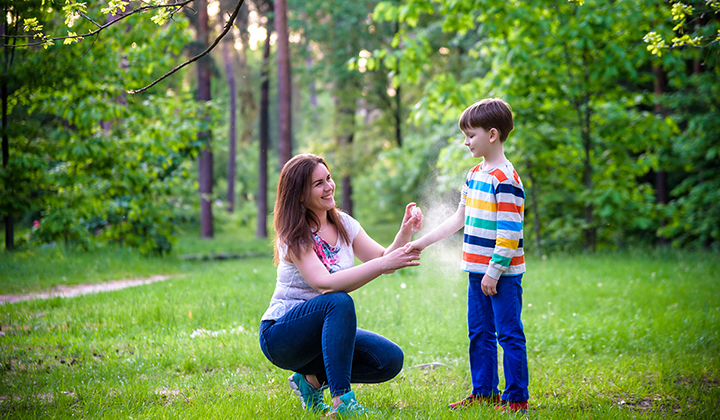Stick it to ticks this summer – easy ways to avoid, remove and treat tick bites

As we kick off the summer season, there’s a lot to be excited about—sunshine, family vacations and tons of outdoor fun. But one thing to remember as your family is outside more often is to check for ticks after playing, hiking or exploring tall grass or wooded areas.
Steering clear of tickborne illness
Most of us associate ticks with Lyme disease, but the type of ticks that carry Lyme disease are not common in the central Midwest. Ticks are so tiny (about the size of a sesame seed) that sometimes people don’t know they’ve had a tick bite unless they develop symptoms of a tickborne disease.
There are 3 tickborne diseases we see most often in Kansas and Missouri:
- Rocky Mountain spotted fever – watch for fever, headache and pinpoint or reddish rash that starts on the palms and soles of the feet.
- Tularemia – causes an infection in the tick bite area, so a skin sore and swollen lymph nodes are often the first signs.
- Ehrlichiosis – symptoms include fever, flu-like symptoms and rash on the belly or back.
These diseases can be serious, and you may need a trip to your primary care provider if you notice any of the symptoms. But the good news is very few ticks are actually infected with a transmittable disease and removing the tick within 24 hours greatly reduces chances of an infection. So, most likely, if you do find a tick on your child, it won’t cause major harm.
Antibiotics like doxycycline are helpful to getting your little one to feel better if they are diagnosed with a tickborne disease. However, most children don’t need to start antibiotics for a tick bite if they don’t have any symptoms of illness.
Ways to prevent tick bites
It’s helpful to take steps ahead of time to prevent tick exposures as well as carefully check clothes, bodies and gear when you come indoors.
Preparing for ticks before you go outdoors:
- Dress to protect. Wear long pants, long sleeves, and a hat when you’re going to be in an area where ticks are common (tall grass, woods and brush). If you spend a lot of time outdoors, you can even buy clothing and gear treated with permethrin, a substance that repels ticks.
- Spray away. Use an insect repellent like DEET wipes or spray to protect any exposed skin. According to the American Academy of Pediatrics, DEET-containing repellents are safe to use on children over 2 months old. Other options are repellents with the active ingredient picaridin, oil of lemon eucalyptus or IR3535 (double-check the label of any insect repellent to be sure it’s safe to use on your child).
- Mind the pets. Make sure all your pets are treated with appropriate flea and tick measures as well.
Checking for ticks when you come indoors:
- Check the hiding spots. Carefully check clothes, skin, and hair for ticks. They love to hide, so make sure to look closely—a good rule of thumb is if you don’t need sunscreen on that body part, chances are, a tick will love it!
- Throw it in the wash. Wash clothes in hot water or tumble dry for at least 10 minutes on high heat to kill ticks on clothing.
- Scrub ticks away. Take a shower or bath as soon as possible after being outdoors.
- Check the pets. For outdoor pets, check their coat regularly for ticks that might have hitched a ride inside.
What to do if you find a tick on your child
Eww! There’s a tick on your kid!? What do you do now? If you find a tick on yourself or your child, don’t panic. Remember, a tick that is not attached can’t transmit disease, and ticks that have been attached less than 24 hours are unlikely to make your child sick.
For easy tick removal, remember GPS:
- Grasp the tick with fine-tipped tweezers.
- Pull it slowly straight up and out from the skin.
- Soap the skin around the bite and rinse with water or clean the area with rubbing alcohol.
Get rid of the tick by flushing it down the toilet, putting it in rubbing alcohol or placing it in a sealed bag or container. You do not need to keep the tick. And of course, always wash your hands after removing a tick.
The CDC provides a great illustrated step-by-step guide here on how to remove ticks.
What not to do when removing ticks:
- Don’t use things like nail polish, Vaseline or a hot match to try to remove a tick. It’s better to cleanly remove it as soon as possible.
- Don’t twist or yank while pulling the tick out—you want it all in one piece! If a piece of the tick’s mouth is still in the skin after removal, either take it out with tweezers or keep the area as clean as possible while it heals.
While ticks can be icky, there’s no reason to let them get in the way of your outdoor adventures this summer. Enjoy the outdoors and be safe!

